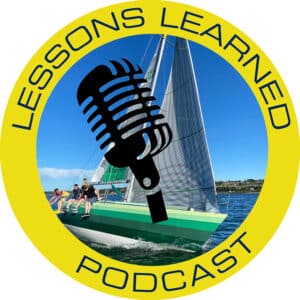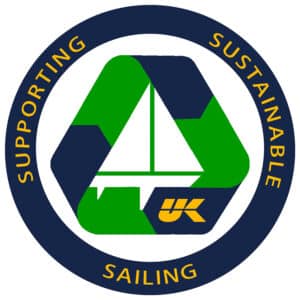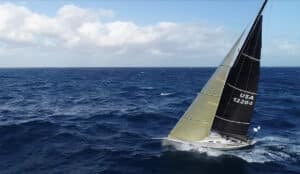Inaugurated in 1946, the Storm Trysail Club’s Annual Block Island Race is one of Long Island Sound’s oldest distance races. Although the race has started and finished at different spots throughout its history, it has always retained the challenge of getting out of the Sound, rounding Block Island and then getting back into the Sound.
From Stamford where the race starts, Long island Sound gets wider and wider (North to South) to a point where off New Haven, it is 17 miles wide. The message here is that if you pick the wrong side of the Sound, you’re in a lot of trouble. Fortunately, the prevailing winds are either southerly or northerly and that will give you a pretty good idea of which side of the Sound will be best.
Once you’re racing, you have to start thinking about which exit from the Sound you’re going to take. As you approach the eastern end of the Sound, it gets much narrower, so the current gets much stronger. You can’t do much about the tide which controls the current but you can sail for the spot you’d like to be in based on how you intend to cope with the current. It is of course, a continually moving target based on how fast you’re going.
The general wisdom says that if you expect foul current, head for the Gut because there are more places to hide and the water is shallower in case you have to anchor.
Also, remember that there is a time difference of approximately one hour between the change of current at the Gut and at the Race.
The eastern part of the race e.g. outside Long Island Sound, abounds with conditions to try a sailor’s patience and skills;
First there is “BLOCK ISLAND SUNSHINE” which is the nickname for some of the thickest fog you’ve ever seen. It is very common during this race because of the warm moist air and cold ocean water. In the days before Loran & GPS, when the only electronic aid to navigation was the radio direction finder, many boats had their races cut short by running aground on Block Island, Fishers Island, Gardiners Island, etc. etc.
Also, the direction of rounding Block Island used to be optional and the scenario of boats going in opposite directions in fog on the east side of the Island occurred all too often. Although no collisions were recorded, there were enough close calls that the option was eliminated by popular demand.
Then there is GROUND SWELL. After leaving Long Island Sound, you are technically in Block Island Sound but that name is deceiving because you’re really in the Atlantic Ocean. You’ll understand that better once you’re east of a line between Montauk Point and Race Rock Light. Ocean waves come rolling in and as the water shoals, they get big and can make sailing tough. They also have a tendency to upset sailor’s stomachs that are used to the sea state in Long Island Sound.
The wind, particularly around Block Island can play some unexpected tricks. For example, if you get too close to the south end of Block Island with a southerly wind blowing, you can suddenly be becalmed. The bluffs lift the wind and there you are on the windward side of an island without a breath. Then, once you’ve escaped the bluffs, you can encounter half a gale on the island’s leeward side. Many a spinnaker met its fate sailing north on the east side of Block Island.
Lastly, there is the ever present current. The water around the island and in Block Island Sound is constantly moving and is always a factor.
Once around the island, you’re faced with picking the best way to get back into the sound. Unless there is a northerly wind blowing, it generally pays to favor the Gut because the course home turns left about 15 degrees once you’re back in the Sound. For brave navigators there is there is another entrance to the Sound between Plum Island and Great Gull Island known as the “Sluice-Way”. In certain conditions, this path can offer some definite current advantages but the water is thin and rocks abound so it is seldom used.
Now, all you’re left with is a leisurely 50 odd miles of sailing back to the finish. Here are two recommendations;
-
If there is a southerly wind blowing, stay close to the Long Island Shore.
-
If the wind is very light and the sky clear, head for the Connecticut Shore. The sun is strong in May but the water is still cold. The land will warm quickly and the temperature differential between it and the water will create a thermal breeze that can be quite strong.
The Organizing Authority for the Block Island Race is The Storm Trysail Club. The 75th Block Island Race will start on Friday, May 28th. PHRF and ORC racing is offered with two courses. One is the traditional Block Island course (186 nm) and the other, for smaller boats, to Plum Island and return (125 nm). For the Notice of Race and other information, use this link to get to the race’s site on Yachtscoring.




Be aware that the Committee can signal a reverse course so that you round BI counter-clockwise. They don’t do it often, but you’d be surprised how many competitors are surprised when they see the fleet coming the other way!
Be aware that the Committee can signal a reverse course so that you round BI counter-clockwise. They don’t do it often, but you’d be surprised how many competitors are surprised when they see the fleet coming the other way!